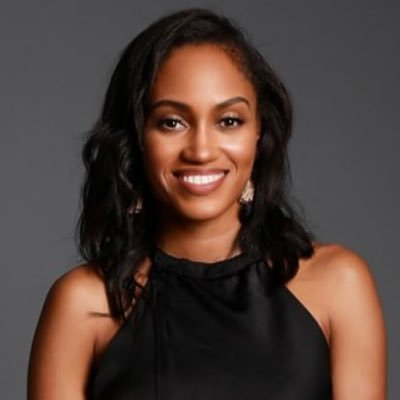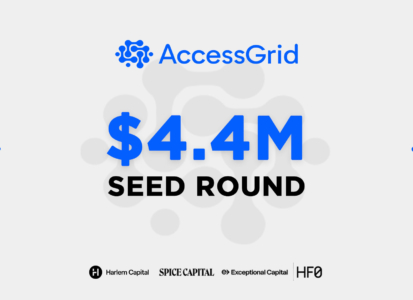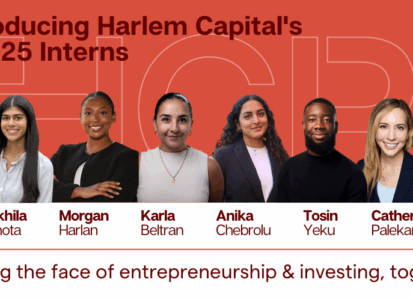More Equity Podcast: Jewel Burks Solomon of PartPic and Google
by Harlem Capital

Part 4 of the Female Founders Series featuring Jewel Burks Solomon of PartPic and Google
As the current head of Google for Startups U.S., Jewel Burks Solomon is on a mission to level the playing field for under-resourced founders in emerging US markets. Prior to her current role, Jewel was the founder and CEO of PartPic, a visual recognition technology company that allows users to save time and money searching for replacement maintenance, repair and operations (MRO) parts. Jewel has also served in various other roles at Google and is a Howard University alumna.
Harlem Capital spoke with Jewel about her path through the tech world, why she keeps going back to Google, and why she’s so passionate that women and black entrepreneurs have more support going through the acquisition process.
Interview has been condensed and edited for clarity.
To start off, you’ve had an amazing career through many different parts of the tech world. Could you tell us about your journey and what inspired you to go into tech?
I started in 2009 as an intern in the BOLD program at Google. That’s what got me excited about being in the technology industry. Once I was at Google, I was really fascinated by how well everything operated and intrigued by the industry. I decided to graduate from college early to go back and work full-time. I ended up graduating in 2010 from Howard University and moved out to Silicon Valley to work at Google. My job was in enterprise sales, so I was selling Google Apps to small to mid-sized businesses. I was also experiencing what it was like to be in Silicon Valley at that time. Lots of new companies were starting and I had a front row seat to the startup world. I was really excited about it and thought that it was something I wanted to do at some point.
But I had some family things occur, my grandmother and younger brother got sick and I wanted to be closer to them. I decided to leave Silicon Valley and move to Atlanta so I could be closer to home. I took a short detour out of tech and into industrial distribution, of all places. It was there that I discovered there was a big need for technology in that industry. That’s what led me to start a startup called PartPic, where we created visual recognition technology for parts.
That’s amazing. I’d love to dive into talking more about PartPic, actually. One thing in particular that I think is incredible is that for a while, you balanced both being at Google and building PartPic. Could you talk about how you managed that and any challenges you had?
Honestly, at the time, it wasn’t super challenging to be balancing both things. When I re-joined Google, it was well-known that I had a startup and was pursuing the startup. My Google work and schedule was really flexible. It was really driven by events that were on nights and weekends. There were times when I was working in my PartPic office during the day and doing my work with Google in the evenings and on the weekends. It was a little bit of a flip from how most people would imagine me doing both of these things. Luckily, they were sort of complementary because the work that I was doing for Google was helping entrepreneurs learn how to use Google tools in their business. I was coming from a place of also doing that in my own business and using the skillset that I had learned to help other entrepreneurs. I think the biggest challenge was that because I was working all day and all night and on weekends, there wasn’t much time for personal life or anything else besides the work that I was doing. At that time, I was really excited about the work I was doing and had big goals that I wanted to accomplish, so it didn’t feel like too much of a burden to be doing both things.
That’s amazing that you were able to have that flexibility. Something I’m really curious about is that PartPic is visual recognition software, but you didn’t necessarily have a deep, really specific background in that kind of tech. I’m curious how you built a team around you that would be able to successfully scale the business, both on the business and technical side.
I started by leveraging the network that I did have. For example, when I came up with the idea, one of the first people I reached out to was a friend of mine that I actually met working on Google who had gone on to work at Shazam. I knew that Shazam had, from a product perspective, a similar look and feel as what I wanted for my new idea, as far as being able to press a button and get an answer. When I reached out to my friend, who actually became my co-founder, I leveraged the fact that he was working in a company that actually was using recognition technology, even though it was a different type of recognition. After reaching out to him and talking to engineers at Shazam, I was able to understand what it was that I was actually trying to build and then from there doing more research and realizing that Georgia Tech has one of the top programs in the country for visual recognition technology — this core science behind what I wanted to do. I started to spend time at Georgia Tech and build a network of folks who had the right skillset. That’s how I eventually ended up building a team.
I made a few mistakes as far as folks I originally worked with and them not having the exact skillset. It was a bit of trial and error. I eventually landed on folks like Dr. Nashlie Sephus, who became our CTO and had the exact skillset that was useful. When I met her, she had access and friendships in her department and we were able to bring on several other PhDs in the space. That’s how we eventually got to a world-class engineering team through relationships.
That’s fascinating. Sounds like it’s a lot about being curious, reaching out to people you know already and asking questions. It’s an interesting parallel to Shazam, too. One thing you mentioned that is interesting — you talked about Georgia Tech’s visual recognition program and it sounds like something that’s specific to being in Atlanta. Do you think there were any big differentiators to building PartPic in Atlanta versus somewhere like Silicon Valley, for example?
For sure. I made, at the time, what was not considered a smart decision in founding the business in Atlanta. At the time, most investors I was talking to were trying to convince me to move back to Silicon Valley or maybe to New York. I really thought it made sense for us to be in Atlanta because of access to the talent out of Georgia Tech and the other universities in the city and not just just access, but the ability to bring them on without the competitive landscape that exists in Silicon Valley. It’s competitive in Atlanta, but I think you’re definitely able to get access to high quality engineers with a little less competition than in Silicon Valley. Another big reason for me wanting to stay in Atlanta was access to our customers. I was selling into industrial distributors, retailers, and manufacturers. The companies in that space don’t really have a presence in Silicon Valley or New York, even. Most of them are based in the South or Midwest. It made more sense as far as proximity to customers to be in Atlanta. I was able to get a lot of customers — some in Atlanta, some in Chicago — because of that proximity and I don’t think I would have had that same access had I been in Silicon Valley.
Definitely. The points about cost of talent and where your customers are is great food for thought for anyone thinking about building a business. With that, I’d love to ask you a few questions about your experiences with fundraising and acquisition. In our recent Female Founders Report, we found that of all the founders who had raised rounds of over $1M, the vast majority were seed and Series A — so very early, not close to an exit yet. Since going through an acquisition is a fairly uncommon experience for female founders, I’d love to dive into your experiences with that. At what point in the process of building PartPic did you start thinking about selling and what was your strategic thinking around that decision?
I was thinking about an eventual exit from the beginning. I always considered PartPic to be great technology that would work really well within a larger company, just because we were pretty niche as far as the industry we were going after. We had always considered the business something we would build up and sell. So while I was always thinking about the exit, I definitely didn’t anticipate it at the time that we actually ended up selling.
At the time, I was fundraising, so I was in the middle of raising a Series A, when we were approached by Amazon to sell the business. The decision was really me not being super thrilled with some of the term sheets that I was receiving in the Series A and not feeling like we were getting a fair deal in terms of what was being presented from investors. I was also looking at what was happening in the industry and seeing a trend of visual search technology companies getting bought by Apple, Google, Facebook and realizing that the market we were selling into — we were a bit early for them in terms of their ability to adopt the technology at scale. The reality was that we would have to raise a lot more money to wait out the industry. Those were some of the factors that went into my decision to sell when I did. It happened in real time, it wasn’t like I was going out to market to sell, I was understanding what was happening and the timing of everything and making a decision based on that.
Yeah, that’s really interesting. Something I’m really curious about is as you were raising that Series A, before you got this acquisition offer, what were some of those challenges that you were contending with?
I think the biggest challenge was the fact that we were not being fairly assessed, as far as the progress we had made in relation to the difficulty of the technology we were pursuing. I think that many investors were evaluating us as an enterprise SaaS company, and although we were an enterprise SaaS company as far as our business model, I think a more fair comparison would have been against other artificial intelligence and visual recognition related companies. This is actually how the acquisition came about, which is I was trying to reposition us from the straight enterprise SaaS comparison to more of the AI comparison.
One way I did that was putting our CTO more in the limelight, as far as her doing more public speaking and going to conferences so that people could see the real depth of the technology we were building. That’s how the conversation with Amazon got started — Nashley was speaking at a deep learning conference in Boston and a representative from Amazon corporate development was in the room during her presentation and was intrigued by the technology. While we were fundraising and trying to show people the depth of the technology, I think a lot of investors were not really understanding how difficult it was to build what we had built and what a game-changer it was from a tech perspective.
Definitely. Sounds like an amazing connection to Amazon. Even just with being at Harlem Capital and looking at comps, it’s interesting to think about how being compared to a SaaS vs. an AI company might change things. So, after going through the process of acquisition and being with Amazon for a while, could you talk about the transition coming full circle back to Google and what you do today?
It’s really interesting, I have a funny story in my career, which is that every few years I end up back at Google. It’s really because of the ability to do the work that I really feel passionate about. The chance for me to lead up Google for Startups for the U.S. was something I couldn’t say no to, because it’s what aligned with what I care about most. Google for Startups is all about leveling the playing field for underrepresented startups in the U.S. and other emerging ecosystems around the world. It was really a big honor for me to be tapped to lead the team and something that I’ve enjoyed. I’ve been in the role for almost four months and it’s been incredible to work directly with startups and bring the best of Google to these companies, and actually have a focus this year in Atlanta. That’s also been very aligned with my personal passions and desires, to see the ecosystem here grow.
That’s incredible. It seems like it’s such an integral part of helping startup communities that aren’t just the two big ones that people are constantly think about. A couple of bigger picture questions before we wrap up — based on what you’ve seen throughout your ten or so years in the tech industry, where have you seen tech companies do a good job of moving the needle on issues of racial and gender equity, and where do you think is the biggest area for improvement?
I think that transparency around where the large companies are is something that is a lot better, now. There’s also been a large effort around board composition. In recent years, we’ve seen many more tech companies add people of color and women onto their boards, which makes a big difference, in my opinion. That’s one area that I think is moving in the right direction.
One area where there is definitely still a lot of work to do and where I focus my attention and desire to contribute is around acquisitions. One of the things that is unfortunate is that there have been very few acquisitions by major tech companies of black-founded, Hispanic-founded, women-founded companies. That’s something I really wasn’t aware of until I was trying to do research and figure out if I knew anyone or if anyone in extended networks had gone through the process that I had gone through when I was selling to Amazon and I really couldn’t find anyone. That’s something that I think isn’t talked about enough, because there’s so much wealth that is generated through tech acquisitions and unfortunately black folks haven’t been able to participate. That’s something I’m really passionate about speaking more about and changing. I definitely want to ensure that the next time someone is looking to sell their business to an Amazon or Google or Facebook, there are more people they can reach out to who have done it before.
Yeah, that’s amazing. I think it’s so important to be thinking about when a company gets to a later stage, how can its founder get returns and create that kind of wealth? Finally, would love to hear, as a prominent female leader of color in tech, what pieces of advice do you have for people who are looking up to you and would love to be in your position someday?
I would say that there are no shortcuts. A lot of times people reach out and ask me questions, and I have to remind them that for me, this is year 10 of working in technology and working to be where I am today. It takes a long time and that’s one thing I like to remind people, it feels hard and the journey is difficult, but it really takes hard work and determination and resilience. Even today, I feel like I’m really working hard to continue to achieve goals. Don’t take shortcuts, don’t think that there will be shortcuts, it takes a lot of time to achieve your goals.
Follow Jewel:
Twitter — @jewelmelanie


